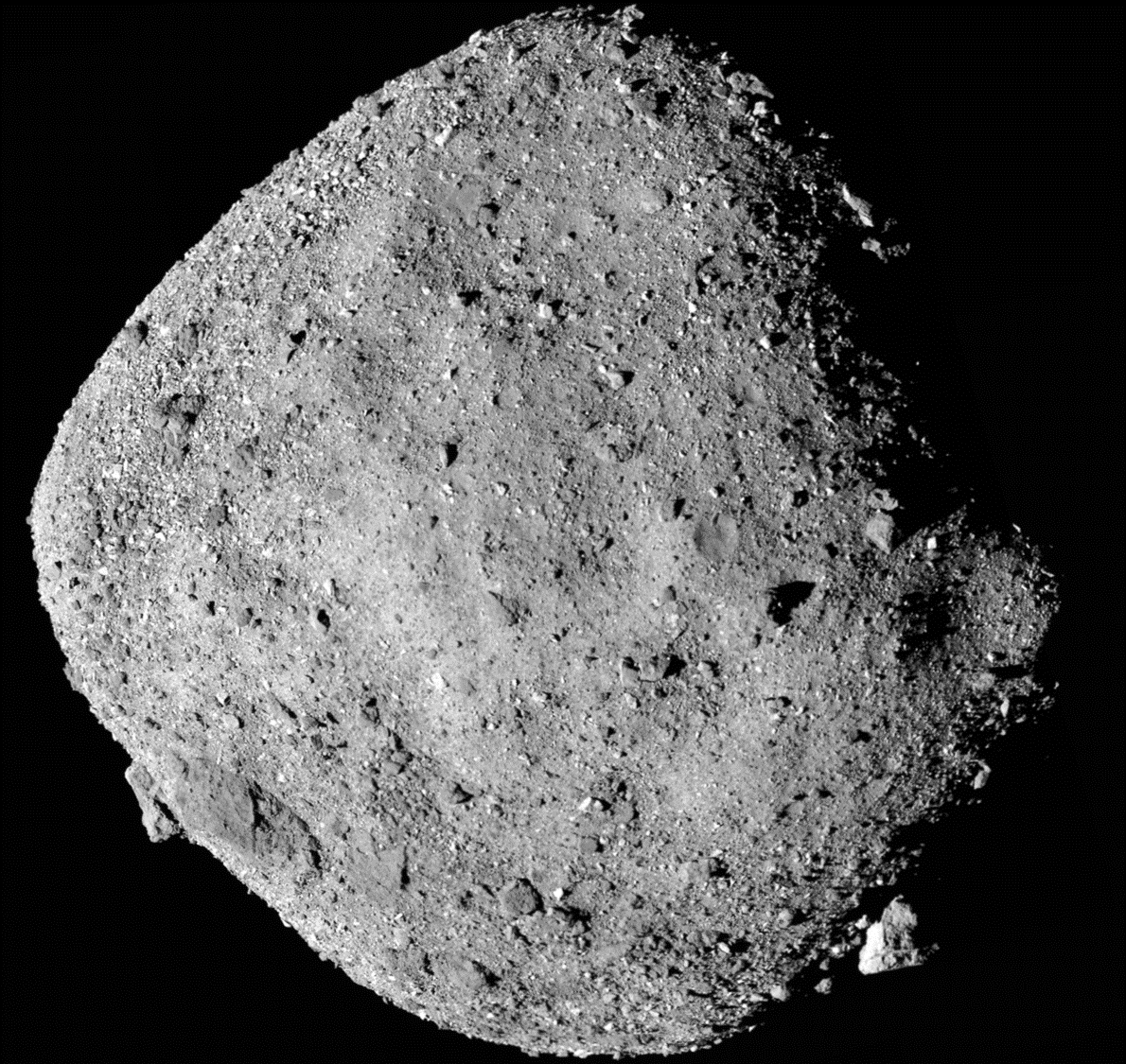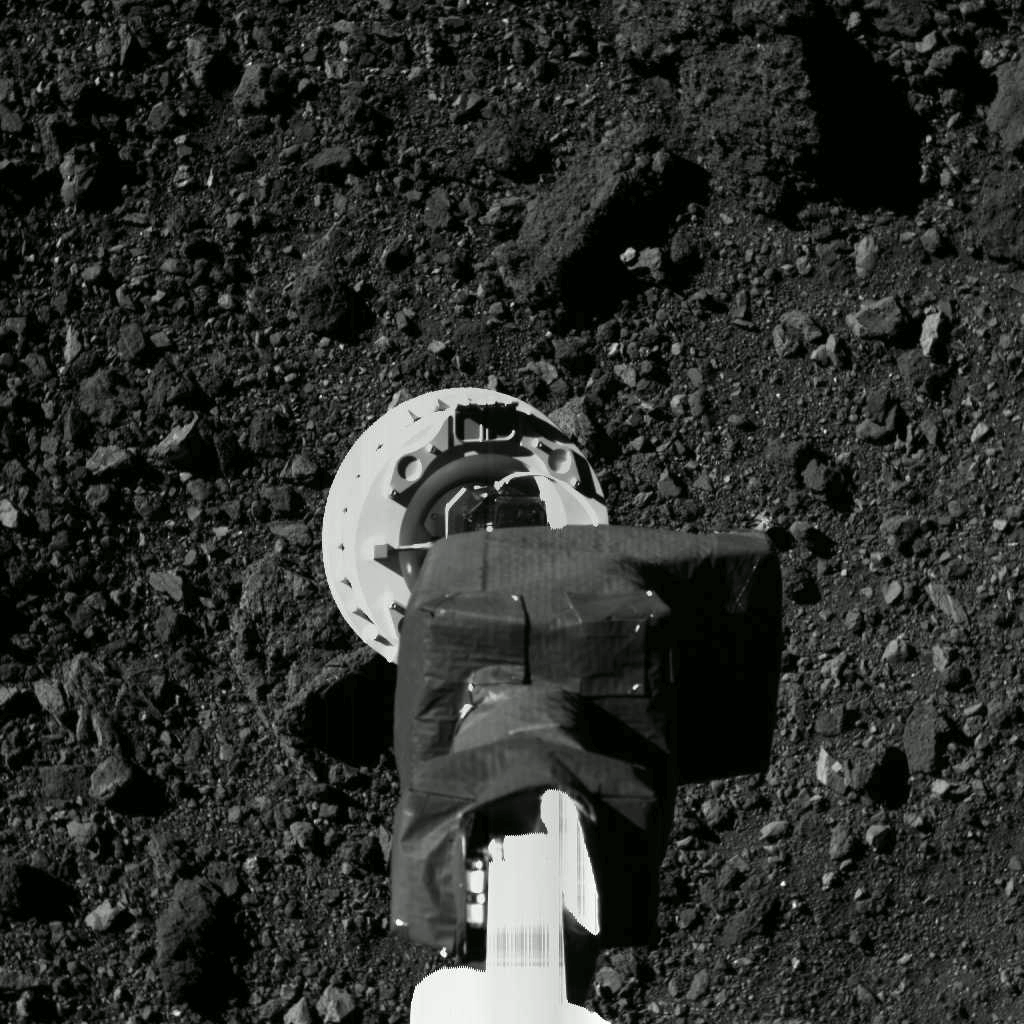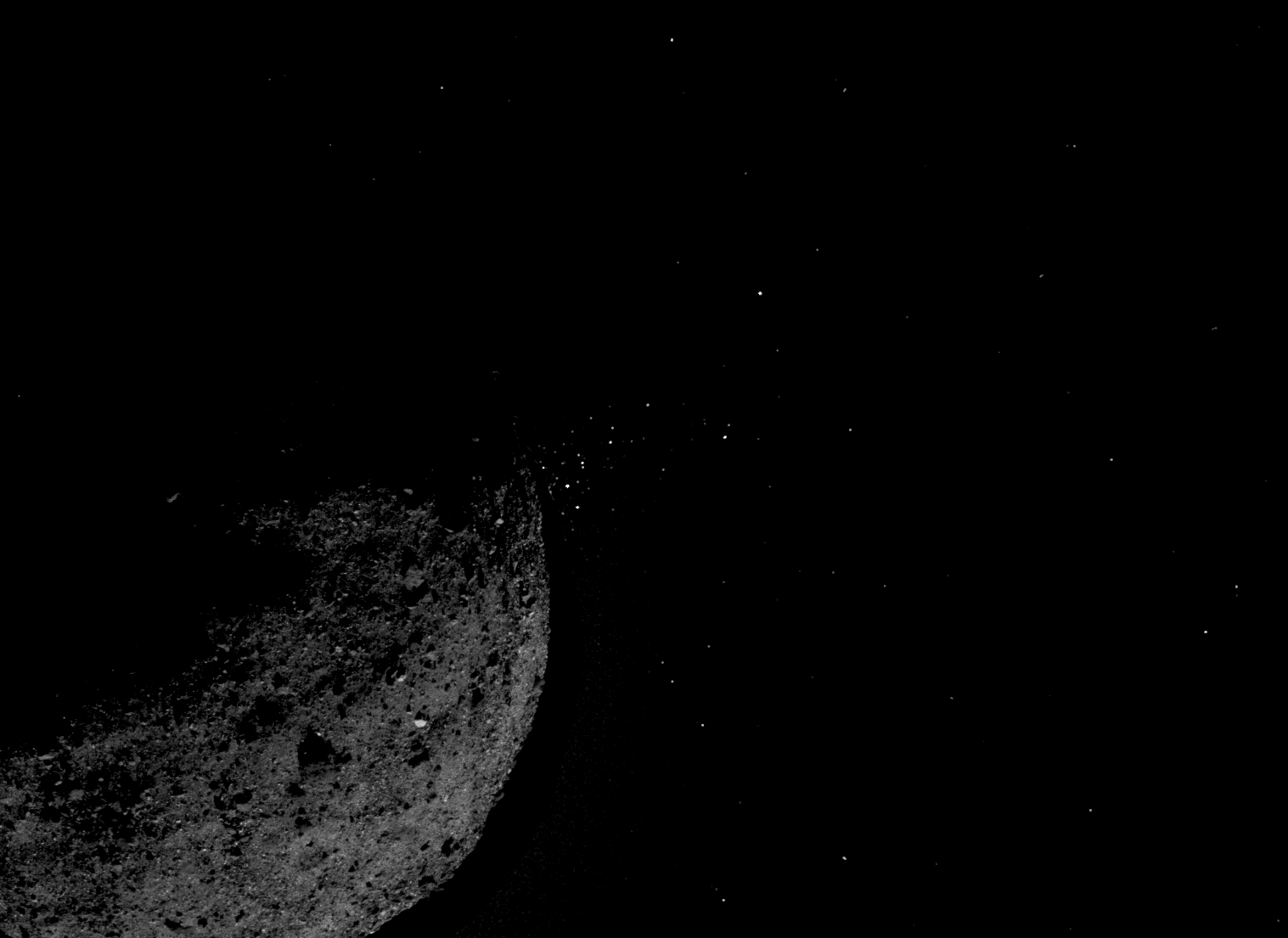NASA’s first mission to return a sample from an ancient asteroid arrived at its target, the asteroid Bennu, on Dec. 3, 2018. This mission, the Origins, Spectral Interpretation, Resource Identification, Security-Regolith Explorer, or OSIRIS-REx, is a seven-year long voyage set to conclude upon the delivery to Earth of at least 2.1 ounces (60 grams) and possibly up to almost four and a half pounds (two kilograms) of sample. It promises to be the largest amount of extraterrestrial material brought back from space since the Apollo era. The 20-year anniversary of the asteroid’s discovery was in September 2019 — and scientists have been collecting data ever since. Here’s what we already know (and some of what we hope to find out) about this pristine remnant from the early days of our solar system.
Credits: NASA’s Goddard Space Flight Center Download video
1. IT’S VERY, VERY DARK…
Bennu is classified as a B-type asteroid, which means it contains a lot of carbon in and along with its various minerals. Bennu’s carbon content creates a surface on the asteroid that reflects about four percent of the light that hits it — and that’s not a lot. For contrast, the solar system’s brightest planet, Venus, reflects around 65 percent of incoming sunlight, and Earth reflects about 30 percent. Bennu is a carbonaceous asteroid that hasn’t undergone drastic, composition-altering change, meaning that on and below its deeper-than-pitch-black surface are chemicals and rocks from the birth of the solar system.

2. …AND VERY, VERY OLD.
Bennu has been (mostly) undisturbed for billions of years. Not only is it conveniently close and carbonaceous, it is also so primitive that scientists calculated it formed in the first 10 million years of our solar system’s history — over 4.5 billion years ago. Thanks to the Yarkovsky effect — the slight push created when the asteroid absorbs sunlight and re-emits that energy as heat — and gravitational tugs from other celestial bodies, it has drifted closer and closer to Earth from its likely birthplace: the Main Asteroid Belt between Mars and Jupiter.
3. BENNU IS A “RUBBLE-PILE” ASTEROID — BUT DON’T LET THE NAME TRICK YOU.
Is Bennu space trash or scientific treasure? While “rubble pile” sounds like an insult, it’s actually a real astronomy classification. Rubble-pile asteroids like Bennu are celestial bodies made from lots of pieces of rocky debris that gravity compressed together. This kind of detritus is produced when an impact shatters a much larger body (for Bennu, it was a parent asteroid around 60 miles [about 100 km] wide). Bennu, for contrast, is about as tall as the Empire State Building. It likely took just a few weeks for these shards of space wreckage to coalesce into the rubble-pile that is Bennu. Bennu is full of holes inside, with 20 to 40 percent of its volume being empty space. The asteroid is actually in danger of flying apart, if it starts to rotate much faster or interacts too closely with a planetary body.
4. ASTEROIDS MAY HARBOR HINTS ABOUT THE ORIGIN OF ALL LIFE ON EARTH…
Bennu is a primordial artifact preserved in the vacuum of space, orbiting among planets and moons and asteroids and comets. Because it is so old, Bennu could be made of material containing molecules that were present when life first formed on Earth. All Earth life forms are based on chains of carbon atoms bonded with oxygen, hydrogen, nitrogen and other elements. However, organic material like the kind scientists hope to find in a sample from Bennu doesn’t necessarily always come from biology. It would, though, further scientists’ search to uncover the role asteroids rich in organics played in catalyzing life on Earth.
5. …BUT ALSO PLATINUM AND GOLD!
Extraterrestrial jewelry sounds great, and Bennu is likely to be rich in platinum and gold compared to the average crust on Earth. Although most aren’t made almost entirely of solid metal (but asteroid 16 Psyche may be!), many asteroids do contain elements that could be used industrially in lieu of Earth’s finite resources. Closely studying this asteroid will give answers to questions about whether asteroid mining during deep-space exploration and travel is feasible. Although rare metals attract the most attention, water is likely to be the most important resource in Bennu. Water (two hydrogen atoms bound to an oxygen atom) can be used for drinking or separated into its components to get breathable air and rocket fuel. Given the high cost of transporting material into space, if astronauts can extract water from an asteroid for life support and fuel, the cosmic beyond is closer than ever to being human-accessible.
6. SUNLIGHT CAN CHANGE THE ASTEROID’S ENTIRE TRAJECTORY.
Gravity isn’t the only factor involved with Bennu’s destiny. The side of Bennu facing the Sun gets warmed by sunlight, but a day on Bennu lasts just 4 hours and 17.8 minutes, so the part of the surface that faces the Sun shifts constantly. As Bennu continues to rotate, it expels this heat, which gives the asteroid a tiny push towards the Sun by about 0.18 miles (approximately 0.29 kilometers) per year, changing its orbit.
7. THERE IS A SMALL CHANCE THAT BENNU WILL IMPACT EARTH LATE IN THE NEXT CENTURY.
The NASA-funded Lincoln Near-Earth Asteroid Research team discovered Bennu in 1999. NASA’s Planetary Defense Coordination Office continues to track near-Earth objects (NEOs), especially those like Bennu that will come within about 4.6 million miles (7.5 million kilometers) of Earth’s orbit and are classified as potentially hazardous objects. Between the years 2175 and 2199, the chance that Bennu will impact Earth is only 1-in-2,700, but scientists still don’t want to turn their backs on the asteroid. Bennu swoops through the solar system on a path that scientists have confidently predicted, but they will refine their predictions with the measurement of the Yarkovsky Effect by OSIRIS-REx and with future observations by astronomers.
8. SAMPLING BENNU WILL BE HARDER THAN WE THOUGHT.
Early Earth-based observations of the asteroid suggested it had a smooth surface with a regolith (the top layer of loose, unconsolidated material) composed of particles less than an inch (a couple of centimeters) large — at most. As the OSIRIS-REx spacecraft was able to take pictures with higher resolution, it became evident that sampling Bennu would be far more hazardous than what was previously believed: new imagery of Bennu’s surface show that it’s mostly covered in massive boulders, not small rocks. OSIRIS-REx was designed to be navigated within an area on Bennu of nearly 2,000 square yards (meters), roughly the size of a parking lot with 100 spaces. Now, it must maneuver to a safe spot on Bennu’s rocky surface within a constraint of less than 100 square yards, an area of about five parking spaces.

9. BENNU WAS NAMED AFTER AN ANCIENT EGYPTIAN DEITY.
Bennu was named in 2013 by a nine-year-old boy from North Carolina who won the Name that Asteroid! competition, a collaboration between the mission, the Planetary Society, and the LINEAR asteroid survey that discovered Bennu. Michael Puzio won the contest by suggesting that the spacecraft’s Touch-and-Go Sample Mechanism (TAGSAM) arm and solar panels resemble the neck and wings in illustrations of Bennu, whom ancient Egyptians usually depicted as a gray heron. Bennu is the ancient Egyptian deity linked with the Sun, creation and rebirth — Puzio also noted that Bennu is the living symbol of Osiris. The myth of Bennu suits the asteroid itself, given that it is a primitive object that dates back to the creation of the Solar System. Themes of origins and rebirth are part of this asteroid’s story. Birds and bird-like creatures are also symbolic of rebirth, creation and origins in various ancient myths.
10. BENNU IS STILL SURPRISING US!
The spacecraft’s navigation camera observed that Bennu was spewing out streams of particles a couple of times each week. Bennu apparently is not only a rare active asteroid (only a handful of them have been as of yet identified), but possibly with Ceres explored by NASA’s Dawn mission, among the first of its kind that humanity has observed from a spacecraft. More recently, the mission team discovered that sunlight can crack rocks on Bennu, and that it has pieces of another asteroid scattered across its surface. More pieces will be added to Bennu’s cosmic puzzle as the mission progresses, and each brings the solar system’s evolutionary history into sharper and sharper focus.

Goddard provides overall mission management, systems engineering, and the safety and mission assurance for OSIRIS-REx. Dante Lauretta of the University of Arizona, Tucson, is the principal investigator, and the University of Arizona also leads the science team and the mission’s science observation planning and data processing. Lockheed Martin Space in Denver built the spacecraft and is providing flight operations. Goddard and KinetX Aerospace are responsible for navigating the OSIRIS-REx spacecraft. OSIRIS-REx is the third mission in NASA’s New Frontiers Program, which is managed by NASA’s Marshall Space Flight Center in Huntsville, Alabama, for the agency’s Science Mission Directorate in Washington.
For more information about NASA’s OSIRIS-REx mission, visit:
By Tamsyn Brann
Media Contacts:
Bill Steigerwald / Nancy Jones























